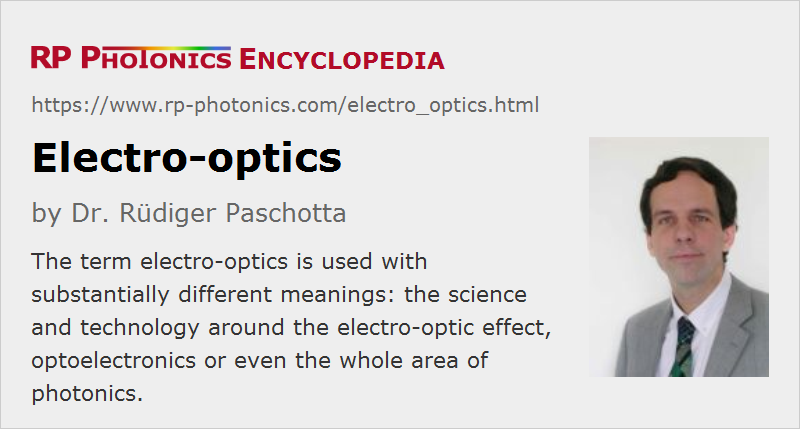Electro-optics
Definition: the science and technology around the electro-optic effect; alternatively: optoelectronics or even the whole area of photonics
German: Elektrooptik
Categories: optoelectronics, physical foundations
How to cite the article; suggest additional literature
Author: Dr. Rüdiger Paschotta
The term electro-optics is used with substantially different meanings, which are explained in the following sections.
Devices Based on the Electro-optic Effect
Electro-optics in a narrow sense is the field of science and technology around the electro-optic effect, i.e., the phenomenon that the refractive index of a material can be modified with an electric field. Mostly, one uses the linear electro-optic effect (Pockels effect), and less often the Kerr effect (quadratic electro-optic effect). The most important kind of electro-optic devices is the electro-optic modulator, containing a Pockels cell as its core element. Besides, the electro-optic effect can also be utilized in the form of electro-optic sampling.
Optoelectronics
A broader understanding of the term electro-optics also includes other devices where optical propagation depends on electric fields – for example, electroabsorption modulators. Next, one may include devices where light causes electrical effects. Electro-optics is then essentially the same as optoelectronics. That can be considered as the technology of electronic devices that interact with light, or essentially the technology where both optics and electronics are involved. This field includes many more devices, such as for example photodetectors, laser diodes and photonic integrated circuits.
Photonics
Sometimes, the term is understood to be even much broader, meaning essentially the same as photonics.
Questions and Comments from Users
Here you can submit questions and comments. As far as they get accepted by the author, they will appear above this paragraph together with the author’s answer. The author will decide on acceptance based on certain criteria. Essentially, the issue must be of sufficiently broad interest.
Please do not enter personal data here; we would otherwise delete it soon. (See also our privacy declaration.) If you wish to receive personal feedback or consultancy from the author, please contact him e.g. via e-mail.
By submitting the information, you give your consent to the potential publication of your inputs on our website according to our rules. (If you later retract your consent, we will delete those inputs.) As your inputs are first reviewed by the author, they may be published with some delay.
See also: electro-optic effect, electro-optic modulators, electro-optic sampling, photonics, optoelectronics
and other articles in the categories optoelectronics, physical foundations
 |




If you like this page, please share the link with your friends and colleagues, e.g. via social media:
These sharing buttons are implemented in a privacy-friendly way!